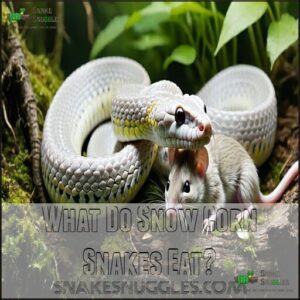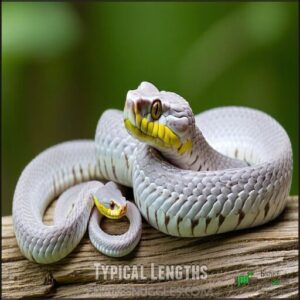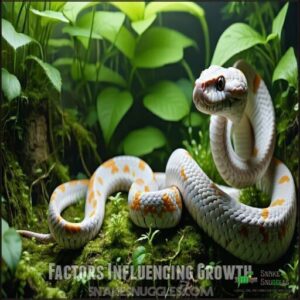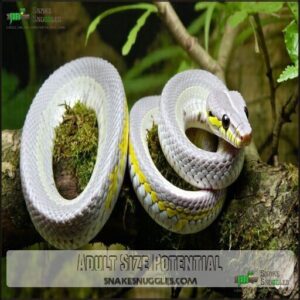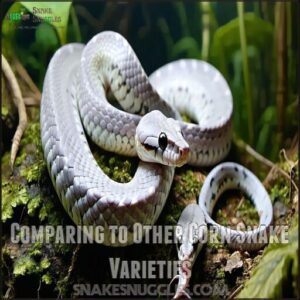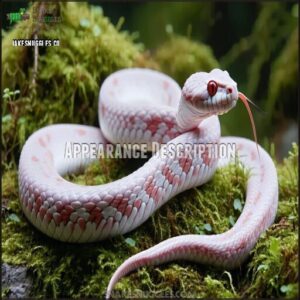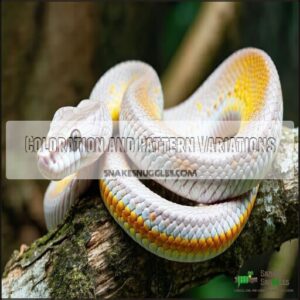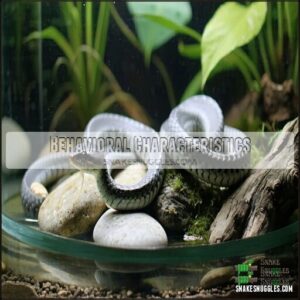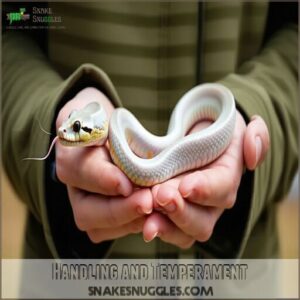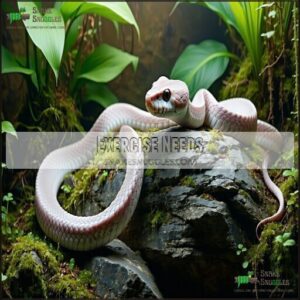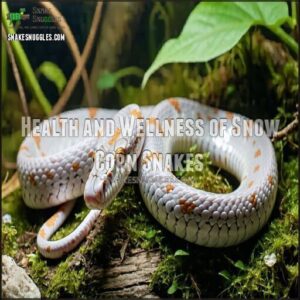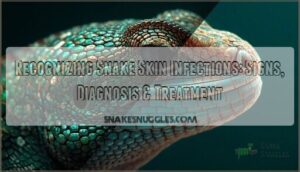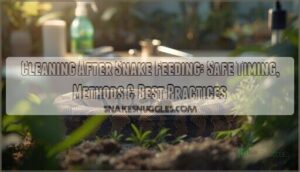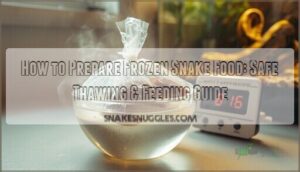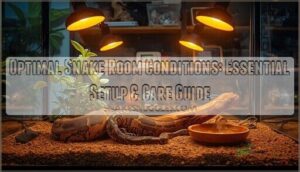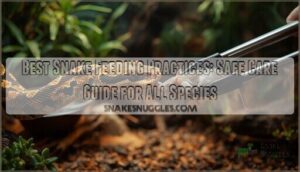This site is supported by our readers. We may earn a commission, at no cost to you, if you purchase through links.
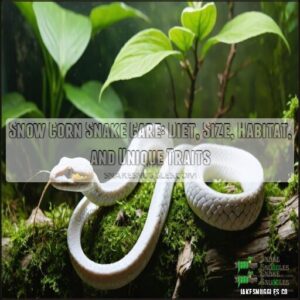
As you care for your snow corn snake, you’ll want to know it’s a docile pet that requires a balanced diet, proper habitat, and regular handling.
To provide the best possible care, you need to understand its specific needs, from feeding schedules to habitat setup.
By learning about the snow corn snake’s traits, you’ll be better equipped to provide the best care, and that’s just the beginning of creating a happy and healthy environment for your pet.
Table Of Contents
- Key Takeaways
- What Do Snow Corn Snakes Eat?
- Snow Corn Snake Size and Growth
- Unique Traits of Snow Corn Snakes
- Habitat Setup for Snow Corn Snakes
- Health and Wellness of Snow Corn Snakes
- Frequently Asked Questions (FAQs)
- What does a snow corn snake look like?
- What are baby Snow corn snakes being sold?
- How long do snow corn snakes live?
- Are snow corn snakes easy to care for?
- Do snow corn snakes metamorph?
- What is the scientific name of snow corn snake?
- Is a snow corn snake rare?
- Are snow corn snakes good pets?
- Are snow corn snakes bred in captivity?
- What is a snow corn snake?
- Conclusion
Key Takeaways
- You’ll want to feed your snow corn snake a balanced diet of frozen-thawed mice or rats, with prey size matched to the snake’s widest part, to ensure proper nutrition and prevent obesity.
- You’ll need to set up a suitable habitat for your snow corn snake, with a temperature gradient of 75-90°F, humidity levels of 65-75%, and a substrate that balances humidity retention and ease of cleaning.
- You’ll appreciate the docile nature of snow corn snakes, making them ideal for beginners, and you’ll want to handle them gently and frequently to build a bond and support their overall health and well-being.
- You’ll need to monitor your snake’s health closely, watching for signs of stress or illness, and take preventative measures, such as regular veterinary check-ups and proper hygiene practices, to prevent common health issues like mouth rot and parasites.
What Do Snow Corn Snakes Eat?
Snow corn snakes primarily eat appropriately sized rodents, such as mice, which provide the essential nutrients they need to thrive.
Snow corn snakes thrive on rodents like mice for essential nutrients.
In captivity, feeding frozen-thawed prey is safer and more convenient than offering live animals.
Typical Diet in Captivity
What keeps a snow corn snake healthy and happy? A balanced diet! These non-venomous constrictors thrive on rodent feeders like frozen-thawed mice or rats.
Here’s how to guarantee proper nutrition:
- Prey Size Matters: Match prey size to the snake’s widest part.
- Use frozen mice instead of live prey to avoid injuries.
- Properly thaw prey at room temperature or in warm water before feeding.
- Avoid overfeeding to prevent obesity—too much food can harm their health.
- Stick to a consistent snake diet with no need for extra supplementation.
Following these tips guarantees a healthy, well-fed snake while supporting natural feeding behaviors safely and effectively!
Feeding Schedule
Feeding your snow corn snake on a regular schedule is essential for its health.
Follow this guide:
- Hatchlings: Feed once weekly with appropriately sized prey.
- Juveniles: Offer meals every 5–7 days to fuel growing bodies.
- Adults: Feed every 7–10 days, ensuring prey size matches the widest part of their body.
Always thaw frozen mice properly and avoid live feeding to reduce regurgitation risks.
A balanced diet requires occasional prey variety like quail eggs.
Prey Options
Offering the right prey options for your snow corn snake guarantees proper nutrition and growth.
Hatchlings thrive on pinkies or fuzzies, while adults prefer larger rodents like adult mice or small rats.
Always use frozen-thawed mice, as they’re safer than live prey.
Prey size is vital—never exceed 1.5 times the snake’s girth.
Here’s a helpful guide:
| Prey Stage | Appropriate Prey | Feeding Frequency |
|---|---|---|
| Hatchlings | Pinkies or fuzzies | Every 5–7 days |
| Juveniles | Juvenile mice | Every 5–7 days |
| Adults | Adult mice/small rats | Every 7–10 days |
For reptile owners, bulk purchasing options can be convenient.
Using tongs mimics hunting and enhances feeding, providing a natural way to feed your snake, ensuring healthy growth and safe feeding practices.
Nutritional Requirements
Understanding your snow corn snake’s nutritional needs is pivotal for its long-term health.
Their diet should consist solely of appropriately sized prey to prevent obesity and digestive issues. Frozen-thawed mice are a safe, humane choice, though live prey may be an option for picky eaters.
- Prey Size: Always match the rodent’s size to the widest part of your snake’s body.
- Supplementation Needs: Rotate in calcium and multivitamins occasionally.
- Hydration Importance: Always keep fresh water available, preferably in a dish large enough for soaking.
Transitioning Diet for Different Ages
As your snow corn snake grows, its diet changes to match its needs.
Hatchling feeding starts with pinky mice or frozen-thawed crickets every 5–7 days. Juvenile portions shift to fuzzies or appropriately sized rat pups weekly, guaranteeing prey isn’t larger than the snake’s girth.
Adult prey typically includes full-grown mice every 7–10 days, focusing on proper portion sizes to avoid obesity.
- Hatchlings: Pinky mice or insects, feeding 5–7 days apart.
- Adults: Larger prey like thawed full-size mice weekly.
Consistent snake feeding using frozen-thawed options guarantees health and simplifies care.
Snow Corn Snake Size and Growth
Snow corn snakes typically grow to between 3 and 5 feet in length, reaching their full size by around 2 to 3 years of age.
Their growth depends on factors like diet, habitat conditions, and overall health.
Typical Lengths
A snow corn snake’s size is one of its many striking traits.
Hatchlings typically measure 10–12 inches, showcasing rapid growth during their first year.
Adult snow corn snakes range from 3 to 4 feet in length, with exceptional cases reaching a maximum length of 6 feet.
Observing their Growth Stages, you’ll find Size Variation influenced by genetics, diet, and care quality.
Male corn snakes tend to be slightly larger, adding to their unique Snake Morphs.
This slender build and Average Increase make tracking their development a satisfying experience for any snow corn snake enthusiast.
Growth Rate
Growth in snow corn snakes is fascinating to observe, with a rapid rate seen in their hatchling and juvenile stages.
They often triple their size within 1-2 years with proper care.
To maintain their steady development:
- Feeding Impact: Offer appropriately sized prey at regular intervals to match their growing girth.
- Environmental Factors: Keep a temperature gradient of 75-90°F to support metabolic activity.
- Humidity Support: Maintain 65-75% humidity to facilitate smooth shedding and overall growth.
Steady care guarantees reaching their adult size potential.
Factors Influencing Growth
You play a significant role in your snow corn snake’s growth. Factors influencing growth include genetic potential, temperature gradient, and prey size.
A suitable environment fuels growth, while the wrong one can stunt it. Proper care, such as adequate hydration levels and shedding frequency, supports healthy development.
By considering these factors, you can promote a thriving snow corn snake, ultimately reaching its adult size potential and comparing favorably to other corn snake varieties, with a typical growth rate driven by genetics and care.
Captive corn snakes need specific humidity levels to thrive, and a suitable environment is crucial for their healthy development and proper care.
Adult Size Potential
Having considered the factors influencing growth, let’s look at what size your adult snow corn snake could reach.
You’ll find they typically reach 3-4 feet. Some may even grow up to 6 feet!
Here’s what affects their size:
- Length Expectations: Most stay within the 3-4 foot range.
- Size Variation: Genetics and care influence this.
- Sexual Dimorphism: Males might grow slightly longer.
- Adult Weight: Typically 500-700 grams.
- Genetic Influence: Well-bred snakes tend to thrive.
As your snake reaches its maximum length, consider an enclosure upgrade. Snake size matters!
Comparing to Other Corn Snake Varieties
You’ll notice snow corn snakes stand out among corn snake morphs due to their unique Morph Genetics.
- They exhibit Color Intensity variations
- Display Pattern Uniqueness
- Show no Temperament Differences, simplifying Care Complexity for the albino corn snake and other corn snake varieties, including snow corn snake morphs with distinct snake coloration.
Unique Traits of Snow Corn Snakes
You’ll notice that snow corn snakes have some distinct characteristics, including their striking pink and white coloration, which is due to a lack of melanin.
Snow corn snakes boast striking pink and white coloration due to their unique genetic makeup.
As you learn more about these snakes, you’ll discover their unique traits, such as their docile temperament, slender bodies, and red or orange eyes, which set them apart from other corn snake varieties, showcasing their distinct characteristics.
Appearance Description
You’ll notice the snow corn snake’s striking appearance, characterized by a melanin deficiency, resulting in pink and white coloration.
As an albino corn snake, it features red or pink eyes. Its slender body shape and smooth scale patterns create a unique look.
Newborn snow corn snakes display this amelanistic trait, with eye color ranging from red to pink.
The snow corn snake’s appearance is a result of its genetic makeup, making it a fascinating creature with distinctive markings and a beautiful, pale color scheme, including its scale patterns and body shape, which is also influenced by its genetic makeup.
Coloration and Pattern Variations
You’ll find snow corn snakes have albino genetics, resulting in unique color morphs with gentle scale shades, showcasing diversity in corn snake coloration and visual appeal through selective breeding of these stunning albino corn snake morphs.
Some breeders focus on the amelanistic, or amel trait to enhance these colors.
This approach allows for the creation of various corn snake morphs with distinct visual characteristics.
Behavioral Characteristics
Beyond their pretty colors, snow corn snakes have cool behaviors. You’ll see that these docile snakes enjoy their alone time.
Here’s what to expect from your snow corn snake:
- They aren’t big on
Social Interaction. - They’re stealthy hunters.
- They’re escape artists.
Activity Patternsshow they’re night owls.- Stress shows as hiding or not eating.
Understanding snake behavior and snake temperament makes snake handling easier. A docile temperament makes them great pets.
Their cognitive abilities are interesting. Enjoy your docile snake!
Handling and Temperament
You’ll appreciate the docile nature of snow corn snakes, making them ideal for beginners.
With gentle temperament, they’re perfect for child handling. Master safe handling techniques, supporting their body and avoiding quick movements.
Handling frequency depends on the snake’s comfort level. As a beginner snake, they’re forgiving, but watch for temperament changes, like hissing.
Their gentle temperament makes snake handling a breeze, allowing you to build a bond with your pet, which is a key aspect of their gentle temperament.
Exercise Needs
To keep your snow corn snake healthy, provide exercise opportunities.
Add climbing structures and enrichment activities to their enclosure.
Consider:
- Climbing opportunities
- Enrichment activities
- Visual stimulation to promote muscle tone and prevent limited exercise, enhancing snake enrichment with rock formations or silk plants to improve overall health through exercise.
Habitat Setup for Snow Corn Snakes
You’ll need to set up a suitable habitat for your snow corn snake, considering factors like enclosure size, temperature, and humidity.
By creating an environment that mimics their natural habitat, you’ll help your snake thrive, so this is vital to get the setup just right.
Ideal Enclosure Size
When setting up your snake terrarium, consider space utilization and enclosure depth.
Choose a tank size of at least 120x60x60 cm, ensuring enough vertical space and hiding spots for your snake.
Select a suitable tank material for your snake enclosure, balancing enrichment needs with safety and proper ventilation.
Ideal conditions also include maintaining proper humidity for comfortable shedding.
Temperature and Humidity Requirements
To create a suitable environment, you’ll need to manage temperature and humidity.
Consider these factors:
- Heating Methods
- Humidity Control
- Thermostat Use
- Monitoring Tools
Maintain a healthy environment by controlling humidity levels for ideal snake temperature and humidity, ensuring a suitable space.
Lighting Needs
When designing your snake habitat, consider lighting needs.
- UVB benefits for overall health
- Albinism sensitivity to light
- Light cycles mimicking natural patterns
Use low-intensity UVB lights and heat lamps with a temperature gradient. Avoid harsh brightness, opting for soft ambient light.
Proper snake lighting supports well-being and natural behavior, especially with albinism sensitivity. Consider UVB product options for your snake.
Balance lighting needs with temperature and humidity for a comfortable snake habitat.
Substrate Choices
You’ll want a substrate that balances humidity retention and ease of cleaning.
Consider:
- Cypress mulch for humidity control
- Aspen shavings for burrowing
- Bioactive substrates for a natural environment.
Some owners specifically utilize cypress mulch products for reptile enclosures.
Avoid pine or cedar to prevent substrate impaction, opting for safe snake substrate like aspen shavings or cypress mulch, and remember to clean frequently.
Decor and Enrichment Options
You’ll enhance your snake’s enclosure with tank decor, including climbing branches and hiding spots.
Add enrichment toys and naturalistic bioactivity for environmental enrichment, making your pet’s home engaging and comfortable.
With water features and snake hides to complete the setup, you will create a comprehensive environment that includes naturalistic bioactivity.
Health and Wellness of Snow Corn Snakes
You’ll want to monitor your snow corn snake’s health closely, as they can be prone to common issues like mouth rot and parasites.
By understanding the signs of stress or illness and taking preventative measures, you can help guarantee your snake lives a long and healthy life, typically ranging from 15 to 20 years in captivity.
Common Health Issues
Monitoring your snow corn snake’s health is essential.
Watch for signs of Mouth Rot, Snake Mites, and Respiratory Infections.
- Common issues include shedding problems
- Parasite control is essential
- Respiratory infections can be deadly
Regular check-ups prevent complications, ensuring your pet’s overall snake health and well-being by preventing snake diseases and snake mites.
Shedding Care
You’ll notice your snake shedding regularly.
Control humidity with a damp moss hide to promote smooth shedding. Monitor scale health, addressing stuck sheds or eye caps promptly.
Proper substrate and clean water access are essential for shedding and overall health.
Be aware of pre-shed signs and handle your snake gently during this time to guarantee stress-free molt management and maintain your snake’s shedding frequency.
Regular Veterinary Check-ups
You’ll keep your snake healthy with regular veterinary checkups.
Discuss preventative care, medical tests, and vaccination needs with your vet.
Consider:
- Preventative care
- Early detection
- Parasite screening
- Health monitoring
- Vaccination needs
Regular veterinary checkups help detect snake health issues early, ensuring prompt treatment and better outcomes for your pet’s overall snake health, which is crucial for preventing diseases.
Signs of Stress or Illness
You’ll spot signs of stress or illness in your snow corn snake through appetite changes, lethargy, or abnormal shedding.
Watch for skin lesions, breathing issues, and other snake health issues, as these can signal snake diseases, requiring prompt attention to prevent serious symptoms and health problems.
Parasite Prevention and Treatment
You’ll want to prevent snake parasites.
To do so, take proactive measures:
- Quarantine new snakes
- Clean enclosures weekly
- Remove waste daily.
Regular deworming treatments and good hygiene practices help prevent mite identification and promote snake health, reducing risks of snake mites and parasite prevention issues, ensuring veterinary options are available for deworming treatments.
Frequently Asked Questions (FAQs)
What does a snow corn snake look like?
You’re a detective, and a snow corn snake‘s appearance is a clue: it has a pink and white coloration, red or orange eyes, and a slender body, lacking melanin.
What are baby Snow corn snakes being sold?
You’re likely finding baby Snow corn snakes being sold as hatchlings, typically 6-12 inches long, feeding on pinkies or fuzzies, and requiring proper care for healthy growth and development.
How long do snow corn snakes live?
You’ll be pleased to know that, on average, these snakes live 15-20 years in captivity, making them a long-term, loving companion with proper care and attention always.
Are snow corn snakes easy to care for?
You’ll find caring for them straightforward, as they’re non-venomous, calm, and easy to handle, making them a great pet for beginners and experienced owners alike, with proper care and attention.
Do snow corn snakes metamorph?
What’s the magic behind transformation? You won’t see snow corn snakes undergo metamorphosis like frogs; they grow, shed, and develop, but don’t transform drastically.
What is the scientific name of snow corn snake?
You’ll identify the scientific name as Pantherophis guttatus, a species of non-venomous snake commonly known for its various color morphs, including the snow corn snake variant.
Is a snow corn snake rare?
Like a hidden gem, you’ll discover that snow corn snakes aren’t rare, but a popular pet due to their docile nature and stunning appearance, making them a treasured find.
Are snow corn snakes good pets?
You’ll discover they make great pets due to their docile nature, ease of care, and attractive appearance, making them suitable for both novice and experienced snake owners alike always.
Are snow corn snakes bred in captivity?
You’ll find that many snow corn snakes are indeed bred in captivity, making them readily available as pets.
They’re often recommended for novice snake owners due to their docile nature.
What is a snow corn snake?
You’ll learn that a snow corn snake is a variant of corn snake, characterized by its pink and white coloration, due to a lack of melanin, and docile temperament.
Conclusion
Notably, 75% of snake owners report a strong bond with their pets.
You’ll likely experience this with your snow corn snake, a docile pet.
By following the care guidelines, you’ll create a happy environment for your snow corn snake, ensuring it thrives with a balanced diet, proper habitat, and regular handling, making you a great snow corn snake owner.

